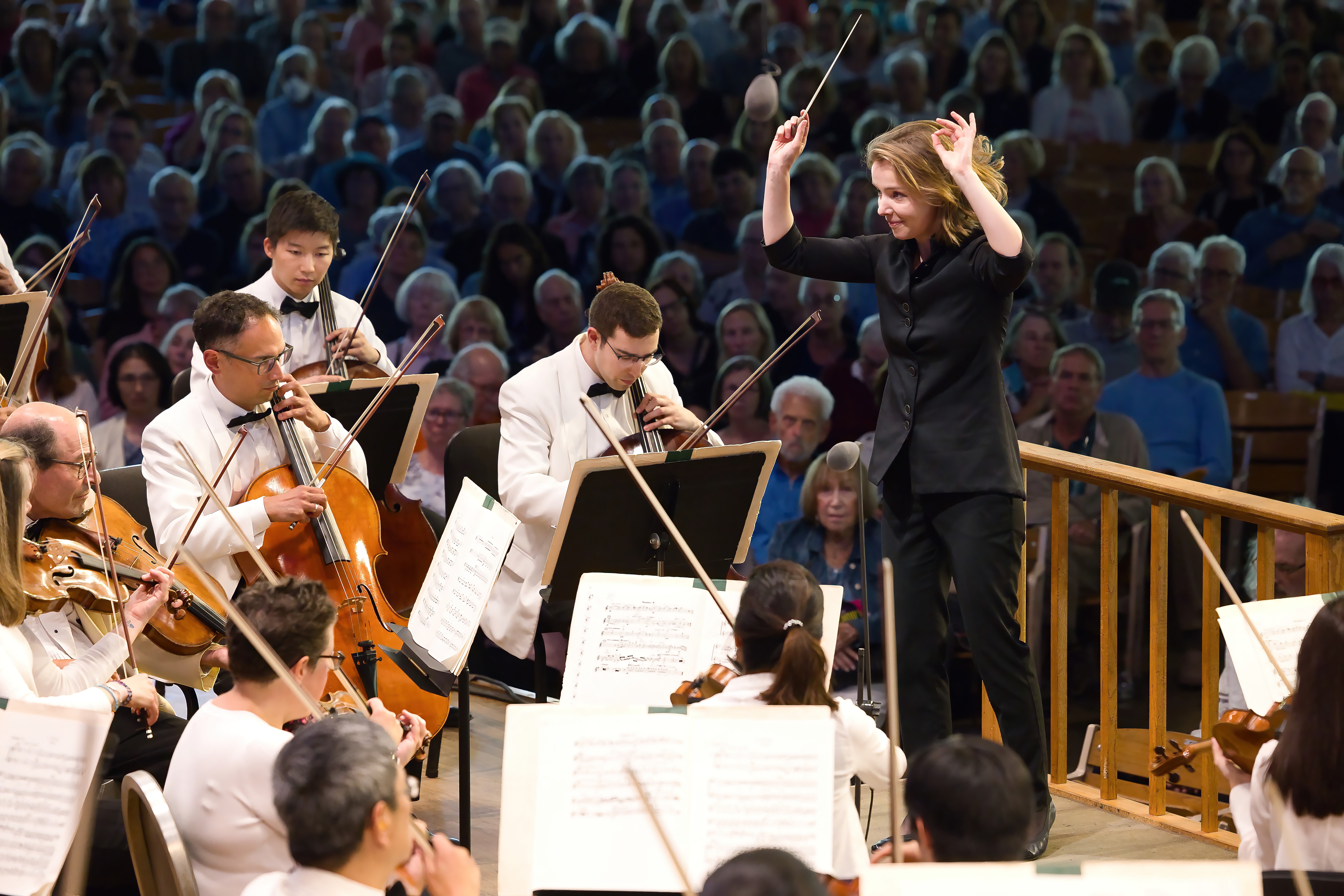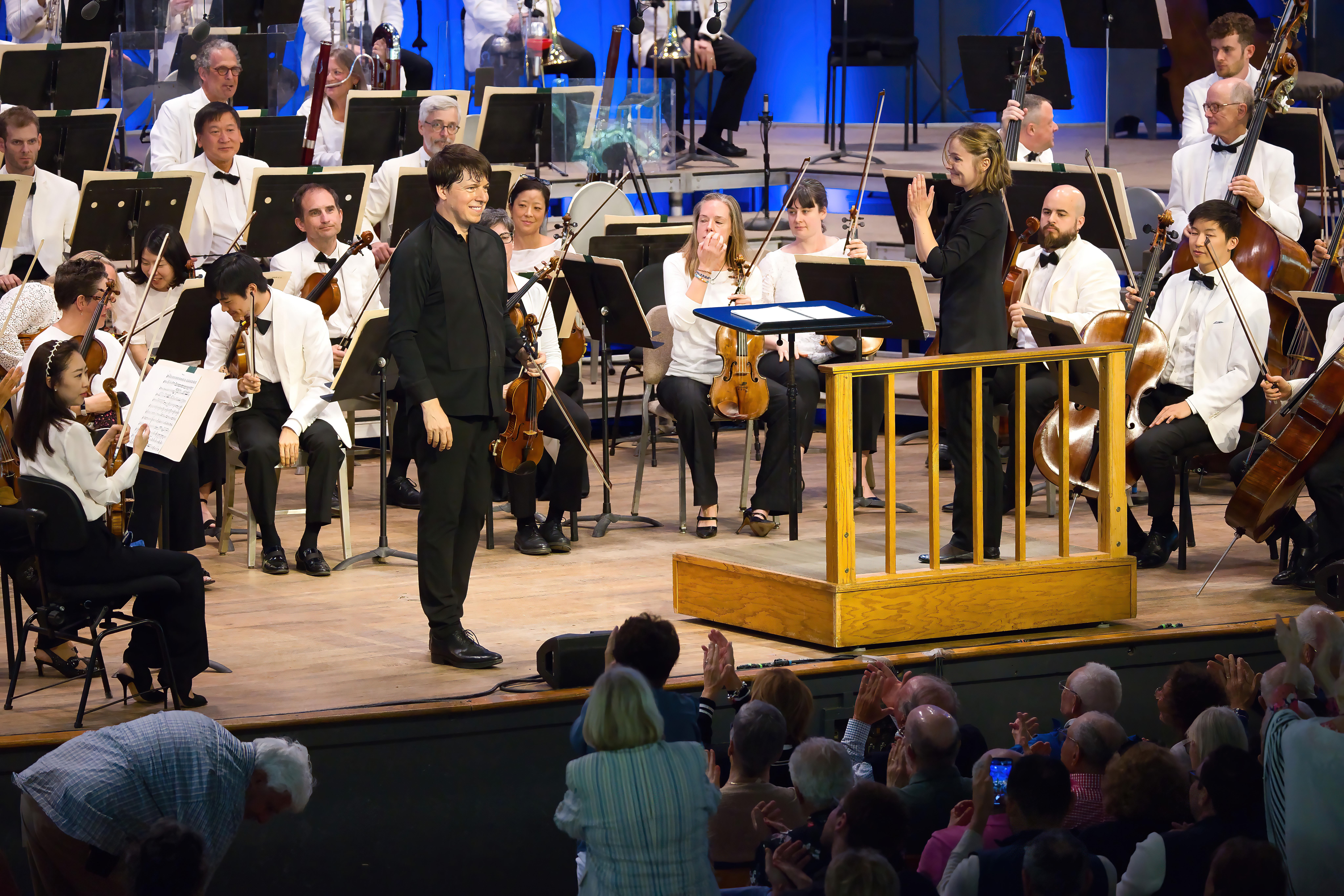
Boston Symphony Orchestra, Anna Rakitina, conductor
Joshua Bell, violin
Eliza Bagg, Martha Cluver, and Sonja Dutoit Tengblad, vocalists
July 30, 2023
LENOX – The Boston Symphony’s offerings on the weekend of the annual Festival of Contemporary Music dovetailed with its curation, lifting up female composers and, on Sunday, a conductor. Leading the orchestra on Saturday, July 30th was Anna Rakitina, who has served as the ensemble’s Assistant Conductor until this Summer. She is a rising star and led the orchestra with assuredness, providing detailed interpretations of all of the scores on the program. The orchestra, for their part, were responsive to her gestures, clearly enjoying working with Rakitina and the music on offer. There was a poignancy to the event, as it was the conductor’s last performance with the BSO as Assistant Conductor.
Ellen Reid’s When The World as You’ve Known it Doesn’t Exist (2019) opened the concert. Commissioned by the New York Philharmonic as part of their Project 19 initiative, a series commissioning female composers to celebrate the centenary of the Nineteenth Constitutional Amendment, affording women the right to vote. The piece is diverse in terms of its musical language, and Reid does an admirable job bringing together the disparate strands of its formal design. Vocalists Eliza Bagg, Martha Cluver, and Sonja Dutoit Tengblad are go-to performers for new music with superb voices and vivid musicality. When the World … required them to sing untexted sounds, some playful, others earnestly dramatic. The orchestra frequently responded to the motives in the voices, creating a back and forth dialogue that contextualized the singers’ presence as part of the proceedings. Given the weight of some of the textures over which the singers were required to perform, a bit of amplification would be understandable: the amount used was excessive, adding periodic harshness that the vocalists neither needed nor deserved.
The outer sections of the piece explored fluid textures, with frequent glissandos and vocal ululations, juxtaposed with orchestral tutti. The middle section, a jazzy surprise, introduced a dyadic motive that was then put through a setof variations, including an extraordinary series of long trills near its end. The motive then joined the beginning material to cohere into a beguiling conclusion. Reid is an imaginative composer and excellent orchestrator. One hopes the BSO will commission and program more of her work.
The last time that the BSO played Nicoló Paganini’s Violin Concerto No. 1 at the Shed was in 1987, with Midori as soloist. To have to wait a generation to hear them play it again seems a crime, as it is one of most ebullient and virtuosic of nineteenth century concertos. There was significant recompense, however, in the pairing of violinist Joshua Bell with the orchestra. Bell is one of the most acclaimed soloists active today, erudite and thoughtful as well as bestowed with superlative technical gifts. Bell composed his own cadenzas for the concerto, which were idiomatic, exploratory, and incredibly challenging.
The piece is front-loaded, with the first movement lasting twenty and some minutes. Such was the inspired nature of its performance alone, that there was a vigorous standing ovation before the second movement even began. When it did, Bell played the ardent Adagio’s central melody with poise and gravitas. The final movement is a rondo, with a sprightly theme treated to a technical tour de force of variations. Once again, Bell performed his own cadenzas, which were formidable yet delivered with elan. Once again at its conclusion, the audience greeted Bell and the BSO with a standing ovation. There was no encore: how can you top Paganini?

The second half of the concert was devoted to ten selections from Sergei Prokofiev’s Music from the Ballet Romeo and Juliet, Op. 64. The piece contains some of Prokofiev’s most memorable melodies, its rich orchestration tailor-made for the BSO. Rakitina never allowed the music to be overdone, yet brought out the emotive side of Romeo and Juliet. In its Introduction, she urged the strings to swoon, yet made ample room for woodwind and horn solos. “Montagues and Capulets,” perhaps the hit tune of the work, was given a brisk reading that embodied the crackling intensity of the families’ rivalry. Contrastingly, “The Child Juliet” was rendered with an innocent delicacy that was quite touching. Likewise, a yearning quality imbued the “Balcony Scene” with luminous ardor. “The Death of Tybalt,” in a flurry of activity, was jaunty in its opening and bellicose at its conclusion, percussion and brass providing a roaring climax. The orchestra sounded tremendous here.
“The Death of Juliet” concluded the performance with one of the ballet’s most arresting themes, played caressingly by the violins and buoyed by lower strings, with eloquent utterances from the lower brass and a rejoinder by a chorus of woodwinds. Its stark close, all octaves with sepulchral bass, had more pathos than a minor chord could ever supply. From beginning to end, this was an engaging program.
-Christian Carey
